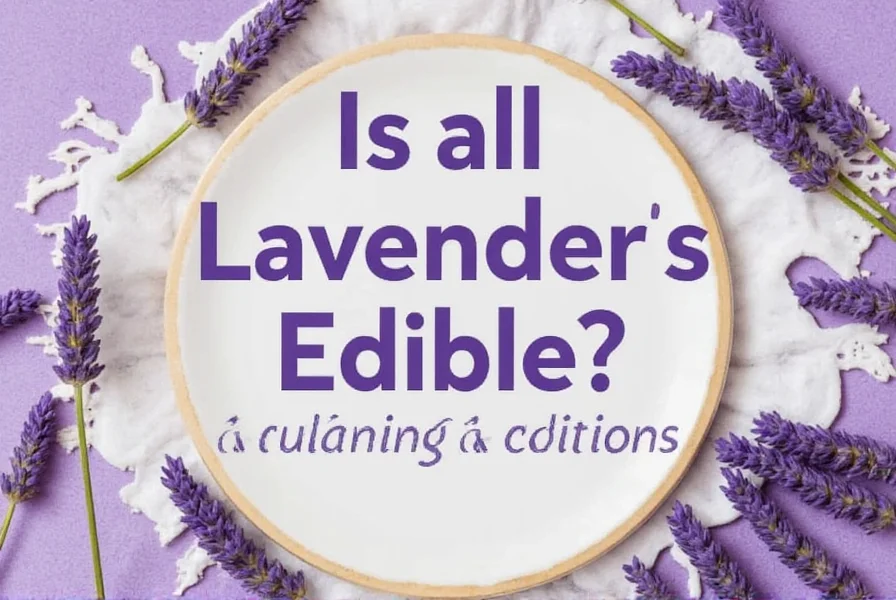Edible lavender is a safe and delicious culinary ingredient when using the right variety (Lavandula angustifolia). Unlike ornamental lavender, culinary lavender is grown specifically for food use and has a pleasant floral flavor. This guide explains everything you need to know about using edible lavender safely and effectively in your cooking.
Frequently Asked Questions About Edible Lavender
What is edible lavender?
Edible lavender refers to specific varieties of lavender, primarily Lavandula angustifolia (English lavender), that are safe for culinary use. These varieties have a pleasant floral flavor profile and are grown without harmful pesticides or chemicals that would make them unsafe for consumption.
Is all lavender edible?
No, not all lavender is safe to eat. Only certain varieties like Lavandula angustifolia are recommended for culinary use. Some varieties, like Lavandula stoechas, can be potentially toxic when ingested. Always check that the lavender is labeled specifically as "food-grade" or "edible" before using it in cooking.
What does edible lavender taste like?
Edible lavender has a distinctive flavor profile that's floral, slightly citrusy, and subtly earthy. When used properly, it adds a sophisticated floral note to dishes without being overpowering. Too much can taste soapy or medicinal, which is why it's important to use it sparingly.
How much lavender should I use in cooking?
A little goes a long way with lavender! Start with just ¼ teaspoon of dried culinary lavender buds per recipe and adjust to taste. For fresh lavender, you'll need about three times that amount since it's less concentrated. Remember, it's easier to add more than to fix an overpowering lavender flavor.
Where can I buy edible lavender?
Look for edible lavender at specialty food stores, herbal shops, or reputable online retailers. Always check that it's labeled as "food-grade" or "culinary" lavender. Some high-quality grocery stores with robust spice sections may carry it as well. Avoid using ornamental lavender from garden centers or florists, as these are often treated with pesticides not intended for food.
How should I store edible lavender?
Store your culinary lavender in an airtight container away from direct sunlight, heat, and moisture. Properly stored, dried culinary lavender can maintain its flavor for 6-12 months. For longer storage, keep it in the freezer in a sealed container to preserve its aromatic compounds.
What are the health benefits of edible lavender?
While not consumed in large quantities, edible lavender contains antioxidants and trace amounts of calcium, iron, and vitamin A. It's naturally caffeine-free and low-calorie. Some studies suggest lavender may have calming properties that could help with relaxation and sleep when consumed in moderation as part of a balanced diet.
Can I grow my own edible lavender?
Absolutely! Growing your own edible lavender is rewarding and ensures you know exactly what goes into your culinary creations. Choose Lavandula angustifolia varieties, plant in well-draining soil with plenty of sun, and avoid using pesticides. Harvest before the flowers fully open for the best flavor, and dry them in a cool, dark place.
What happens if I eat too much lavender?
Consuming excessive amounts of lavender can lead to an unpleasant soapy or medicinal taste in your food. In rare cases, large quantities might cause mild digestive upset. Stick to culinary recommendations (typically ¼-½ teaspoon per recipe for dried lavender) to avoid these issues. Remember that lavender is meant to enhance flavors subtly, not dominate them.
Can I use fresh lavender instead of dried in recipes?
Yes, but you'll need to adjust the quantity. Fresh lavender is less concentrated than dried, so use about three times the amount called for in a recipe. For example, if a recipe calls for 1 teaspoon of dried culinary lavender, use about 1 tablespoon of fresh buds. Be careful not to overdo it, as fresh lavender can still overpower a dish if used excessively.
The Botanical Profile of Lavandula
Not all lavender is created equal. While dozens of lavender species exist, only a few are safe and flavorful for culinary use.
| Species | Culinary Use | Flavor Notes | Safety |
|---|---|---|---|
| Lavandula angustifolia | ✅ Best for cooking | Soft, floral, herbal | Safe when food-grade |
| Lavandula x intermedia | ⚠️ Limited use | Bitter, camphorous | Can cause digestive upset if not distilled |
| Lavandula stoechas | ❌ Not recommended | Harsh, medicinal | Potentially toxic when ingested |

Key Takeaway:
Stick with English lavender (Lavandula angustifolia) for safe and delicious results in the kitchen.
Top 10 Cooking Tips Using Edible Lavender
- Make Lavender Sugar: Infuse granulated sugar with dried buds for desserts and cocktails.
- Create a Floral Syrup: Perfect for lemonade, tea, or pancakes!
- Add to Baked Goods: Try lavender shortbread, scones, or macarons.
- Enhance Sauces and Glazes: Especially effective with lamb or berry reductions.
- Whip Up a Savory Herb Blend: Combine with rosemary, thyme, and oregano.
- Infuse Oils and Vinegars: Ideal for dressings or marinades.
- Use in Sorbets and Ice Creams: Pair with lemon or honey for balance.
- Mix into Herbal Teas: Soothing and aromatic after dinner.
- Experiment with Cocktails: Lavender gin fizz, anyone?
- Try as a Garnish: Lightly dust dried petals on cakes or salads.

Buying Guide: How to Choose the Right Edible Lavender
Choosing the right lavender can be tricky — especially since many commercially sold varieties are treated with pesticides or unsuitable for ingestion.
What to Look For:
- Label Says "Food Grade" or "Edible": Avoid ornamental varieties.
- Dried Whole Flowers or Buds: More potent and authentic than powders.
- Packaged in Air-Tight Containers: Preserves freshness and aroma.
- Organic Certification: Ensures no chemical residues.
- Country of Origin: French or English lavender is often preferred for culinary use.

Recommended Brands
| Brand | Features | Best For | Price Range |
|---|---|---|---|
| Nicholas Farms Organic Lavender | USDA Organic, non-GMO, pesticide-free | Teas, syrups, baking | $$$ |
| The Spice Lab Culinary Lavender | Pure buds, food-grade certified | Cooking, infusions, garnishing | $$ |
| Simply Organic Lavender | Fair-trade, sustainably grown | Home bakers, herbalists | $$ |
Lavender Pairings You'll Love
Like any good spice, lavender shines best when paired thoughtfully. Here are some classic and unexpected combos:
- Lemon + Lavender = Tart meets floral
- Honey + Lavender = Natural sweetness with depth
- Chocolate (especially white) + Lavender = Elegant dessert duo
- Rosemary + Lavender = Earthy and herbal blend
- Lamb + Lavender = Surprisingly sophisticated savory twist
- Berries + Lavender = Bright fruitiness with floral notes
- Gin + Lavender = The ultimate cocktail combo

Grow Your Own Edible Lavender
If you're a culinary gardener at heart, growing your own edible lavender is incredibly rewarding.
Quick Growing Tips:
- Choose a sunny spot with well-drained soil.
- Water sparingly — overwatering kills lavender!
- Prune regularly to encourage bushy growth.
- Harvest in dry weather before blooms fully open.
- Dry in a cool, dark place away from humidity.

Common Mistakes to Avoid
Edible lavender can go wrong if misused. Here are some common errors even seasoned cooks make:
- Using too much: A little goes a long way! Start with ¼ tsp and adjust slowly.
- Mixing with incompatible flavors: Lavender doesn't pair well with strong spices like chili or cumin.
- Storing improperly: Keep in an airtight container away from light and moisture.
- Assuming all lavender is edible: Always check the label.
- Eating ornamental lavender: These varieties may contain chemicals harmful when ingested.
Final Thoughts & Recipes to Try
Edible lavender is more than a trendy garnish — it's a spice that adds sophistication and depth to any dish when used correctly. Whether you're a home cook or a professional chef, experimenting with lavender edible opens up a world of flavor possibilities.
Three Quick Recipes to Get Started:
- Lavender Lemonade: Brew a simple syrup with 1 tbsp dried buds and ½ cup sugar. Mix with fresh lemon juice and water.
- Lavender Shortbread Cookies: Add 1 tsp ground culinary lavender to your favorite butter cookie dough before baking.
- Lavender Gin Fizz: Muddle lavender with simple syrup, shake with gin, citrus, and egg white for a silky cocktail.

So next time you see those lovely purple spikes, don't just smell them — spice up your life by tasting them instead!











 浙公网安备
33010002000092号
浙公网安备
33010002000092号 浙B2-20120091-4
浙B2-20120091-4